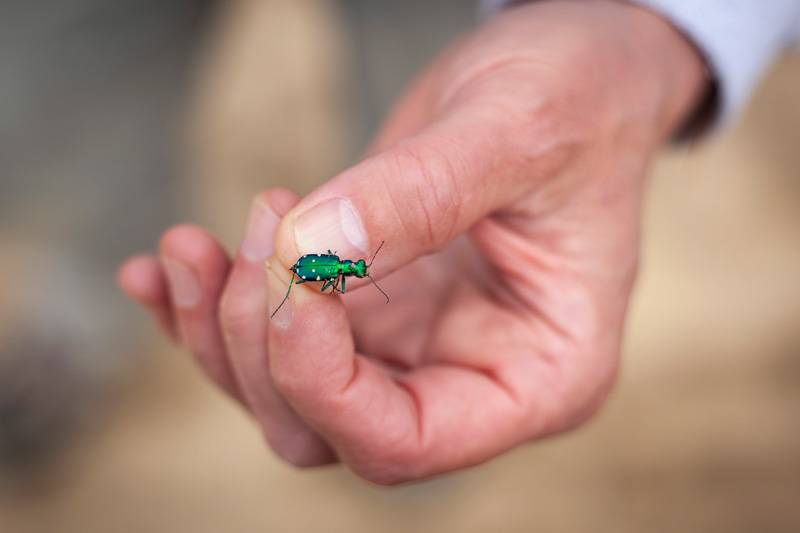An Island biologist gets help from the community to fill in the blanks.
A long morning walk with Matt Pelikan can go all of 400 yards. When I joined him for a stroll along Fire Road D in Edgartown a few weeks ago, we barely went anywhere at all.
That’s because we were looking for insects, something that Pelikan specializes in. We found plenty. Crested pygmy grasshoppers, dusted skipper butterflies, ants, flies, and wasps of many species, and predatory beetles like the shimmering gem Cicindela sexguttata — the six-spotted tiger beetle. “Of course, it has eight spots,” Pelikan joked. (The number of spots, despite the name, can vary.)
It was the bounty of one fraction of the forest, and the Island at large, at just that single moment. “I spend a huge amount of time in the State Forest,” Pelikan told me when we made our plan to go afield. “It’s mostly sandplain, the outwash plain of the Vineyard. It’s a big tract with really good habitat conditions over much of it.”
His strategy, I learned, was to “just sort of kick some bushes and see what we can find.”
“You’ve got to think like a bug,” he advised me. “This looks like it’s all one habitat to us, because we’re gigantic, but if you’re an eighth of an inch long, this is the Serengeti.”
It’s an approachable method, and one that Pelikan, who works at the conservation organization BiodiversityWorks, is hoping to share. He is the director of a new program, the Martha’s Vineyard Atlas of Life, that is designed to foster a growing community of amateur naturalists, and to harness their collective efforts to inventory the Island’s flora and fauna.
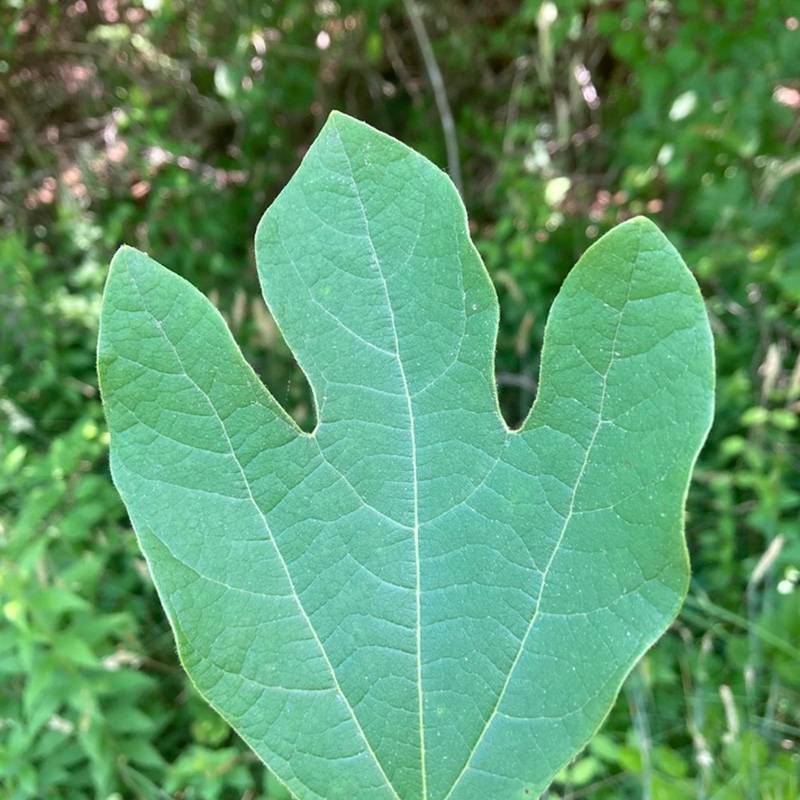
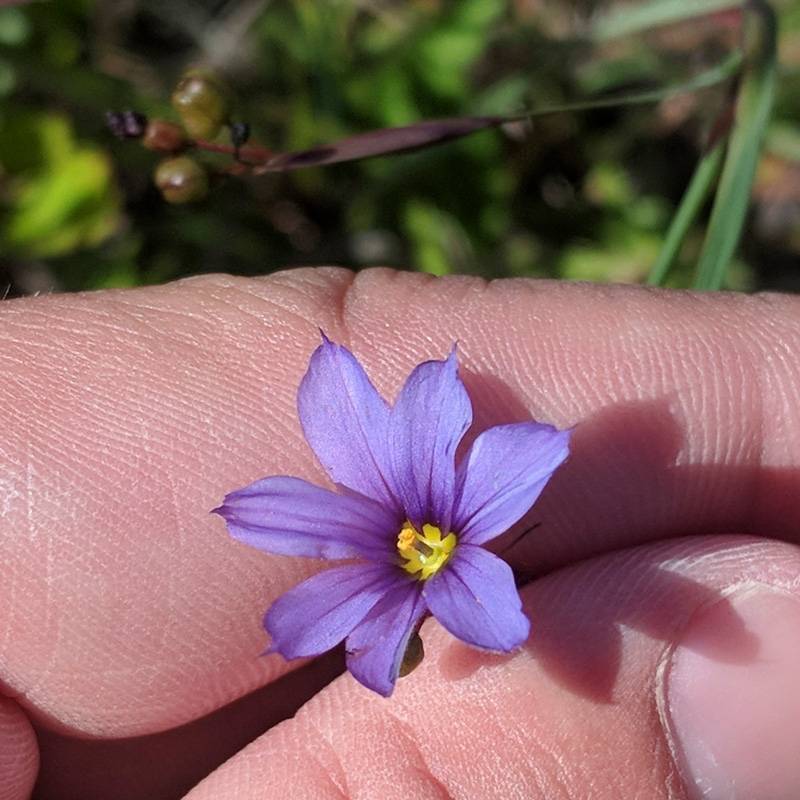
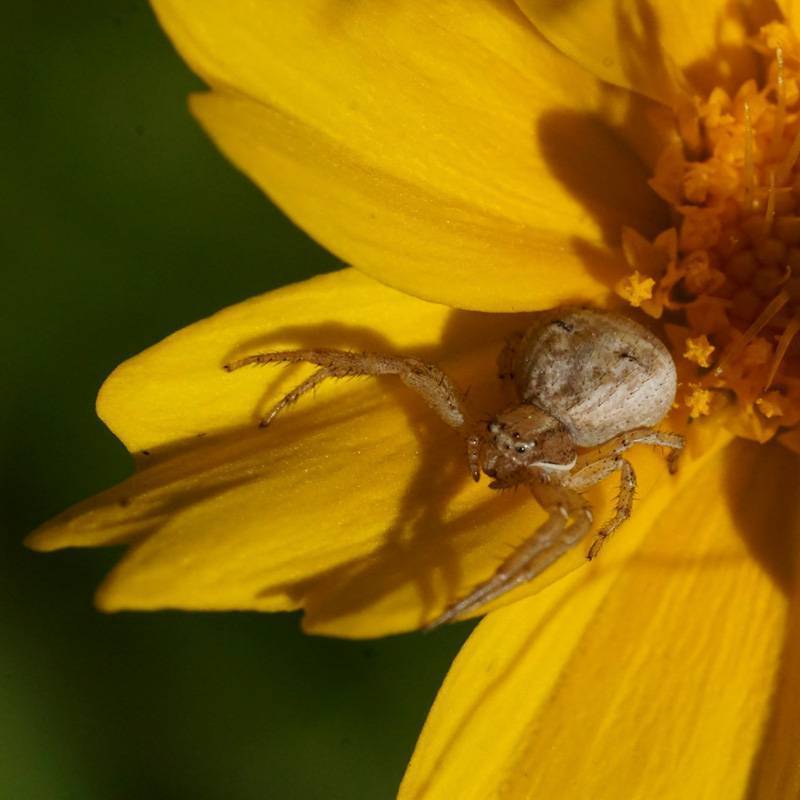
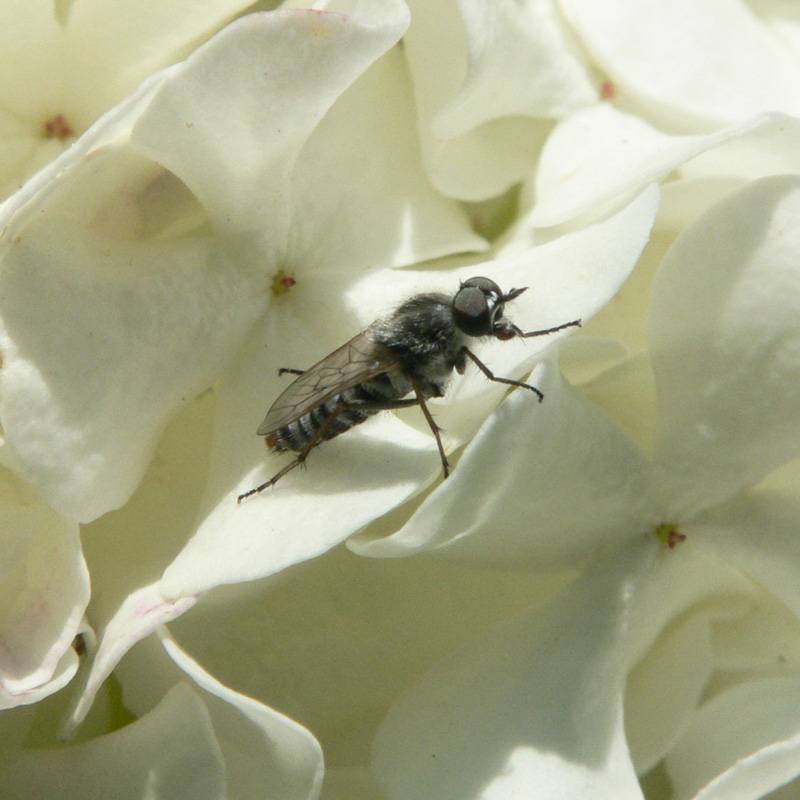
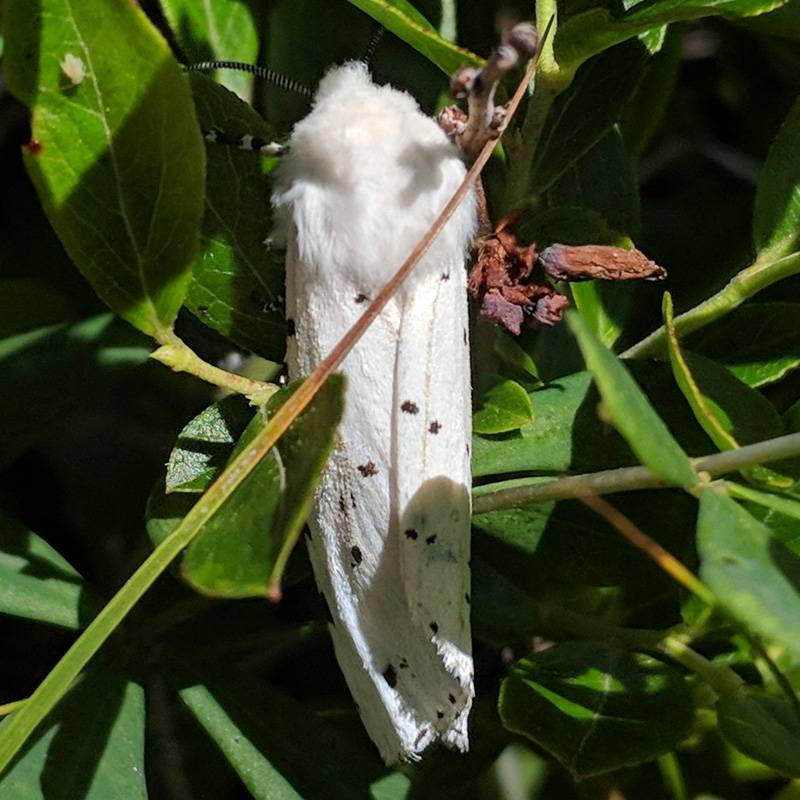
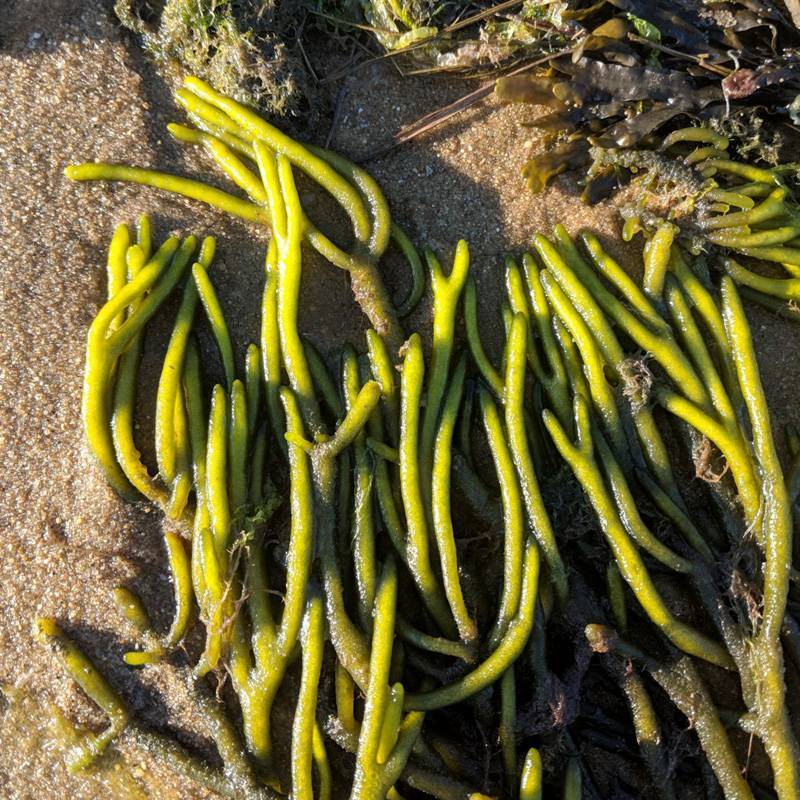
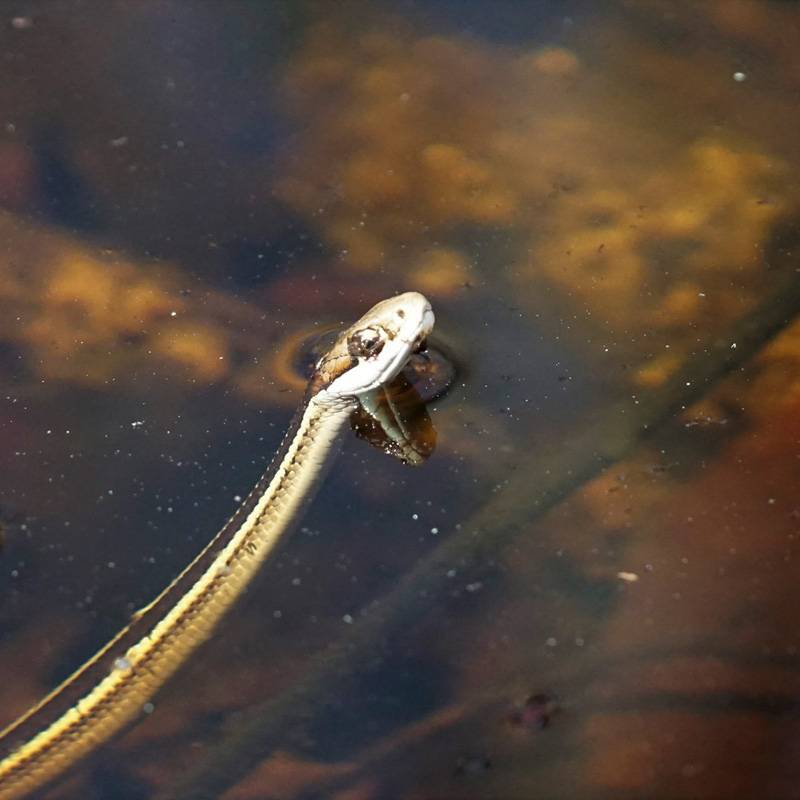
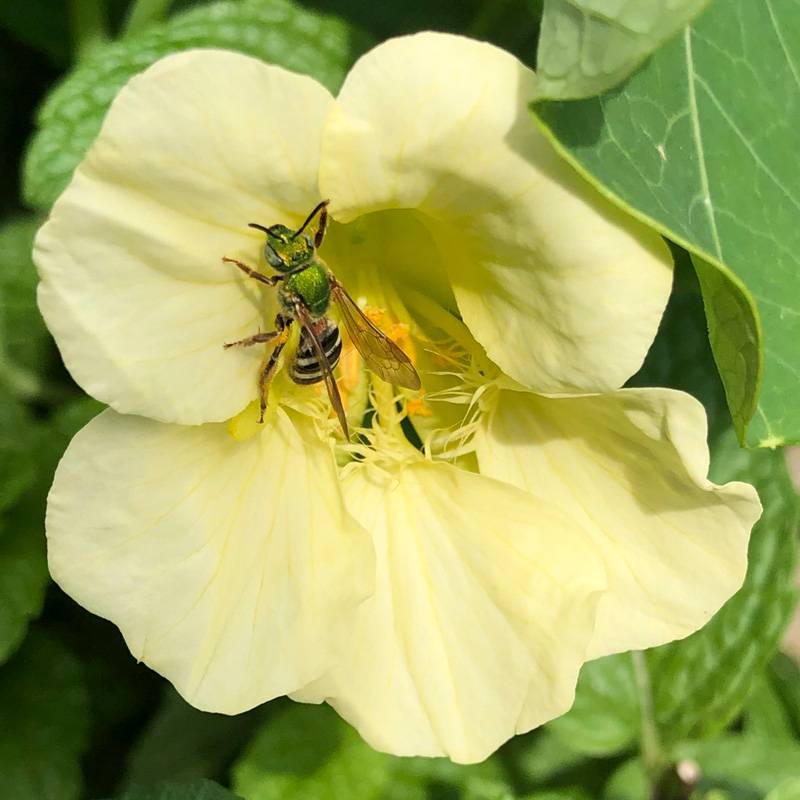
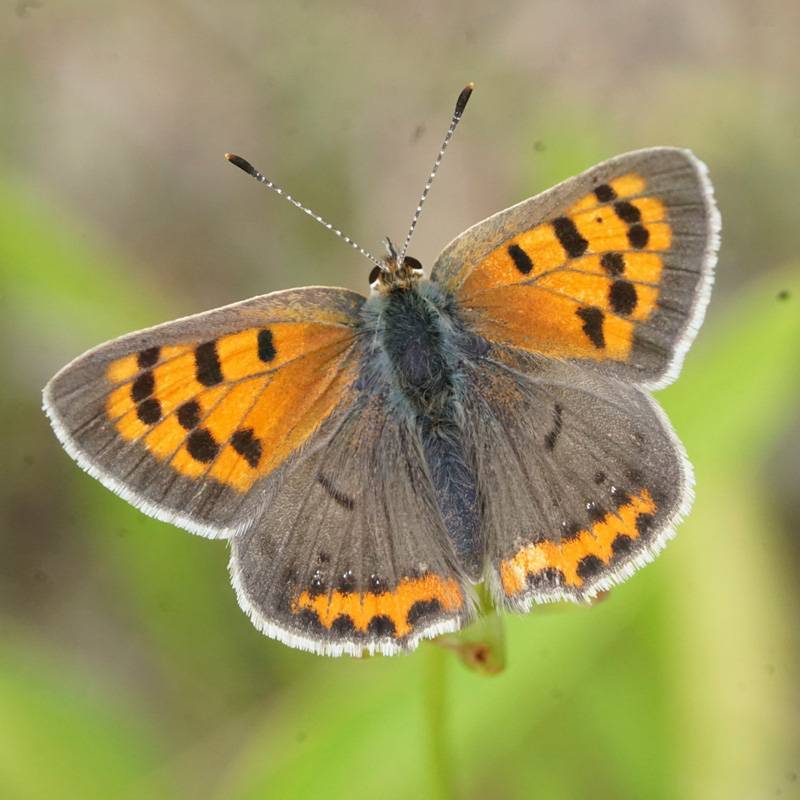
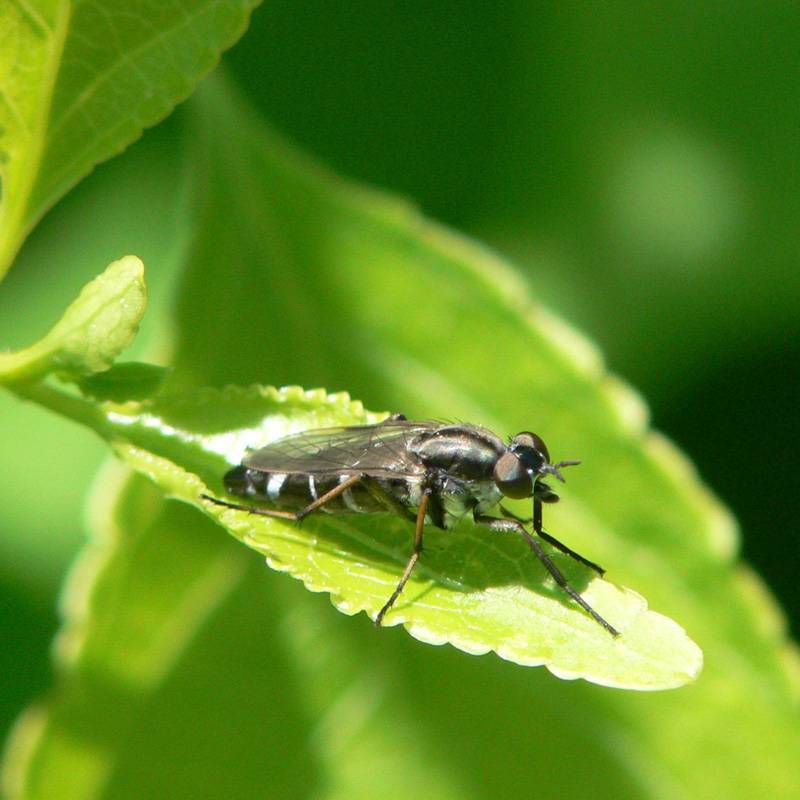
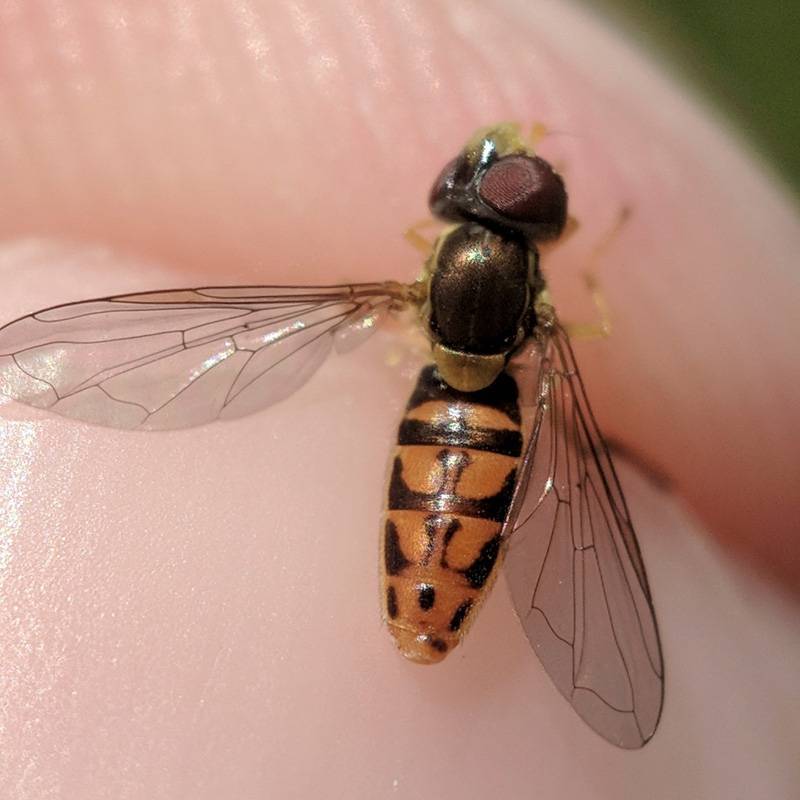
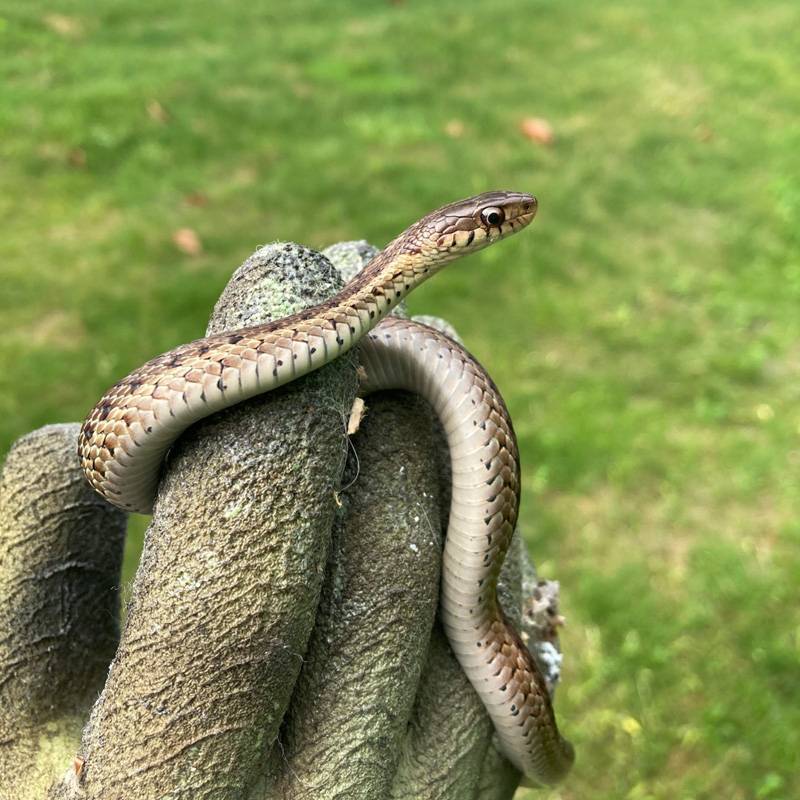
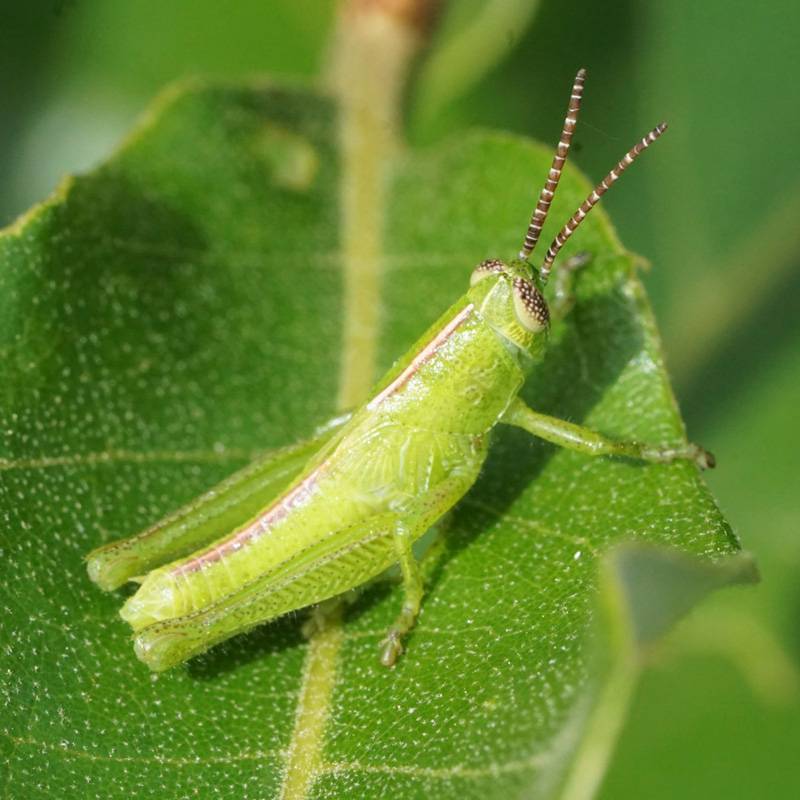
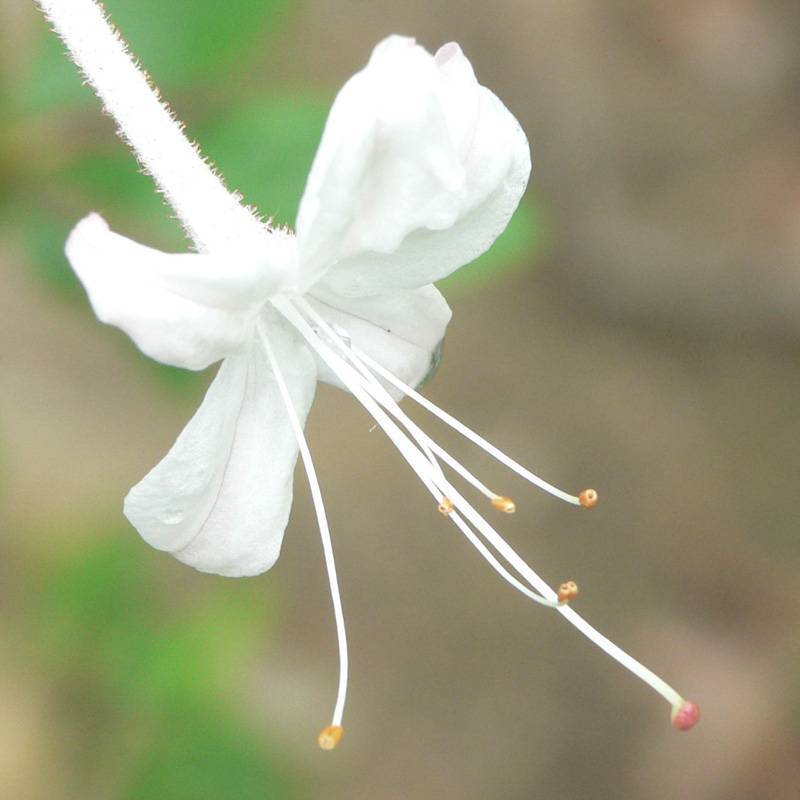
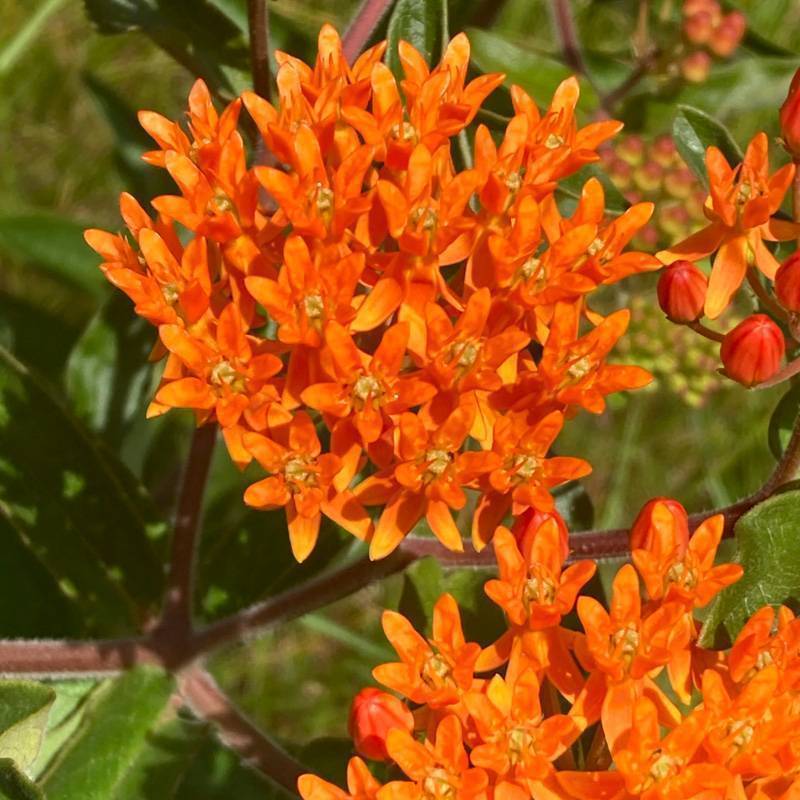
“The point of the Atlas of Life is twofold,” Pelikan said. “The direct one is cataloguing and studying and documenting the biodiversity of Martha’s Vineyard, which is distinctive, both in what we have and in what we don’t have. Because the Island is a distinctive place. It’s got distinctive geology, distinctive land use history; climatologically and in terms of weather it’s unique. All of these things have, over the centuries, added up to a very unusual place. It’s a hotbed of rare species.”
The other point is to encourage a culture of natural history on the Vineyard. “It’s getting people excited about it, and interested in learning more and discovering that they can make meaningful contributions,” he said. He aspires to an ethic of stewardship, “where people have a vested interest in preserving what’s here.”
The project hinges on the unprecedented availability of useful citizen-science tools, chief among them a biology database and social network called iNaturalist. Jointly run by the California Academy of Sciences and the National Geographic Society, the website and its accompanying app have amassed millions of users, and become the primary venue for amateur and professional naturalists alike to share observations and identify species.
Pelikan takes careful photos of the insects he finds, and after our walk he uploaded several sightings to iNaturalist, with a photo and coordinates. Some, including the dusted skipper and the pygmy grasshopper, have since been labeled “research grade” on the app, which means that other users agree with Pelikan’s identification. This label represents the good stuff, from a scientific standpoint — it’s an observation reliable enough to be pulled into regional, national, and international databases that are used by researchers of all stripes.
iNaturalist relies on an active community of people who engage by logging their own encounters and confirming identifications made by others. In the coming months, Pelikan will lead group training on field identification, as well as on the basics of iNaturalist. He led his first, a webinar on Vineyard butterflies, in May. He’s also developing simple, Vineyard-specific identification guides: so far for butterflies in the hairstreak and elfin groups, and tiger beetles. Skill-building, with pointers on identification, places to look, and basic ecology, is his priority, and he is eager to share his love for the search. “It’s what gives me the most satisfaction in life, learning about the natural world,” he said. “Even if it’s negative information. If you go looking for something and you don’t find it, even that is satisfying. I want to proselytize, to give people the gateway drug and get them started.”
The gateway drug, according to Pelikan, is often a butterfly. “People like colorful things, they like things that are big enough to look at easily, and easy to find,” he said. “Butterflies and dragonflies and moths, and vertebrates of course, birds and other vertebrates, are where people tend to gravitate initially.” Pelikan, who himself started as a birder, said, “a common progression is butterflies, and then dragonflies, and then everything else.”
Pelikan is at the “everything else” stage, and it’s an “else” that includes the smallest, most nondescript flies I have ever seen. At one point on our walk, he trailed off mid-sentence, and zeroed in on a fly. “So that fly is a blowfly, I could tell you that,” he said. “I think it’s in the genus Lucilia.” Looking closer, he said, “They spend a lot of time grooming. People say they’re filthy animals, but like most insects, they’re actually pretty clean in their personal habits.”
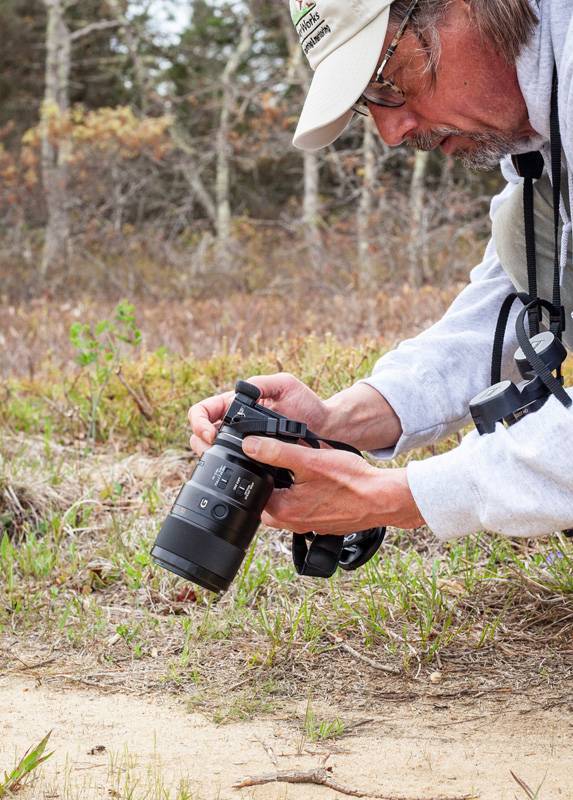
Some of these flies are difficult to identify, even for him. When he hits a wall, he gets help online. “Twenty-five years ago, if you wanted to study flies, you needed to trap them, and you needed to use scientific keys to identify them,” he said. “Now you can take pictures and put them up on iNaturalist, and some graduate student in Ukraine identifies them for you!”
As he says, it didn’t used to be so easy. The first real field guide for birds came out less than a century ago, and specialized guides to many taxa are much more recent. And yet, in many places, communities of amateur naturalists thrived even without these resources. In the 19th century, the study of insects, and of natural history in general, was not only popular — it was posh.
“I think being a little bit of a naturalist was a genteel interest for a rich person to have,” Pelikan said, “and one of the ways that you could display that gentility would be to have people come and visit with you and spend the summer netting moths or looking at the isopods in your ponds or something.” A redux for today’s Vineyard? “I’d love to see it,” he said.
Gone are the days of the entomology aristocracy, when people were dressed to kill (bugs), and crystal glasses clinked over trays of finely preserved orthoptera. But an element of congeniality is still present, and it doesn’t sound half bad. “People have mothing parties,” Pelikan said, “where you get together with a bunch of beer and a white sheet and a black light.” Sign me up.
On the Vineyard, some taxa have held a steady grip on public interest, notably fishes, birds, and of course, our often-seen mammals. “There are studies of fish on the Vineyard going back into the 19th century,” Pelikan said, “and something like 350 species of bony fish are documented here, including these wacky things that come up on Gulf Stream eddies.” Birders, too, are a dedicated community here, who report their sightings, and have a long institutional and communal memory for the comings and goings of species over time.
But there are other limbs on the Vineyard’s ever-branching tree of life. A look at the Atlas of Life page on iNaturalist shows that dedicated hobbyists have already started tiptoeing out onto some.
The last time I checked, iNaturalist showed more than 8,000 observations on the Island, across an astonishing 1,920 species, and more than half of these are “research grade.” About 40 percent of the species observed were insects, but there are a myriad of observations of plants too, followed by birds, spiders, fungi, and mammals.
Tapping the well of natural history enthusiasts on the Island is a task not limited to the present. Pelikan is also thumbing through Vineyard history for observations made years ago, sometimes many years.
“Albert P. Morse,” he said, “my main man.” Morse was an entomologist in the early 1900s who “traveled all around the Eastern United States just collecting grasshoppers and visiting other people who had collections, and taking notes on their specimens. When I found one of his books, it instantly added like four species of orthoptera to the checklist that I was working on, because he had been to the Vineyard a couple of times. That was back in the day when it was all farmland, so it was great habitat for grasshoppers.”
A quality observer like Morse, and a quality observation that matches the habitat you would expect for the time — well, Pelikan says, “you can take it to the bank!”
He’s also working on digitizing “Island Life,” a compendium of local species published a decade ago by naturalists Alan Keith and Steve Spongberg, who drew heavily on the historical record to flesh out a list of known organisms on the Vineyard.
On the reliability of old observations, Pelikan said, “It’s interesting, because while some of it is certainly apocryphal, the standard of performance in amateur naturalists a hundred years ago was actually very, very high. The taxonomy has changed, so there is some reconstruction of what they’re actually talking about sometimes. But these guys were doing it the old-fashioned way: They were getting specimens under microscopes, and drawing sketches and writing detailed descriptions, and a lot of that information is pretty darn good.”
“The Island is a distinctive place. It’s got distinctive geology, distinctive land use history; climatologically and in terms of weather it’s unique. All of these things have, over the centuries, added up to a very unusual place. It’s a hotbed of rare species.” –Matt Pelikan
For lovers of history or seekers of treasure, the Atlas of Life offers a tantalizing combination of detective work and scavenger hunt. Pelikan told me about one butterfly, a species of wetland skipper called a black dash, which hasn’t been seen on the Island since the 1930s. “That doesn’t mean it’s not here,” he said. “It just means that maybe somebody hasn’t looked in the right place.”
There are many species like this, and the question they pose is one that has driven some birders to the brink of madness: Is it truly gone, or are we not looking hard enough? “One record is all you need to demonstrate the existence of something in a place,” Pelikan said. “Demonstrating absence is of course, logically, a lot harder. As the number of total records increases without that species being among them, the odds of it being here get steadily lower, and lower, and lower.”
“If we can find a little population of black dash,” he said, “that would be great to know, because we can try to protect it, we can learn what sort of resources are characteristic about that site, and maybe that will suggest some other places to look.”
A little can go a long way. “If we could get 20 people looking at butterflies, and posting pretty much every butterfly that they saw on iNaturalist,” Pelikan told me, “I would think that would give a very good distribution map for where you could find them, and how widely distributed each butterfly species is. That’s not a huge amount of work, and it’s not unrealistic to think of that happening over the next couple of years. And then you would have a sense of which species are rare and where they occur.”
Pelikan draws inspiration from the Vermont Center for Ecostudies, whose own Atlas of Life project has more than 5 million records, and has identified species new to the region, rediscovered lost ones, and generated a volunteer-driven tapestry of biological communities all around the state.
Community observation, especially coupled with solid advice from professional naturalists on the Island, is an avenue toward building a core competency in the Vineyard community that might come in handy in all sorts of ways.
For example, Pelikan pointed to the popularity of regenerative or restorative agriculture on the Island, where farms try to manage their land in a way that benefits the ecosystems in which they are enmeshed. “It would be great to have a bunch of people who had the skills to do the monitoring to support that,” he said, “so a farm could introduce some kind of change in how they manage their land, and we could have people who had butterfly skills to do periodic butterfly surveys, as volunteers, to document any changes that were occurring.”
These observations do more than nurture a personal checklist. They start to trace, faintly at first, the comings and goings of an immensely variable community of life. Biologists can use them to track the arrival of invasive species, to evaluate the richness or peril of a landscape for a given creature, and to track which conservation measures are having a positive effect on the landscape.
“The main take-home for the project for me would be the social engagement,” Pelikan said, “and how important it feels from a personal level to share my love of studying the natural world. I can say that of the 82 species of butterflies that are known for Martha’s Vineyard, I’ve had 44 in my yard. And it’s a humble yard, believe me, so it doesn’t take much to get pretty impressive biodiversity if you’re paying attention. Taking pride in that sort of thing would be such a huge step in terms of protecting what we’ve got, and getting to understand it better.”
For more information on these programs, visit mval.biodiversityworksmv.org.
Supporting the Island’s biodiversity
The Martha’s Vineyard Atlas of Life project was co-founded by BiodiversityWorks and the Betsy and Jesse Fink Family Foundation, which has strong Vineyard ties and supports local and national conservation initiatives. Warren Adams, an advisor for the foundation, wrote, “With the growing impact of climate change and the omnipresent pressure of development, protecting the Island’s biodiversity is a Herculean task that requires the concerted effort of many individuals and organizations. The mix of citizen science, research-grade data collection and analysis, and collaboration with other on- and off-Island conservation organizations makes the Martha’s Vineyard Atlas of Life a high-impact initiative the Betsy & Jesse Fink Family Foundation is excited to support. We hope this work along with other biodiversity initiatives the foundation is supporting on the Island will make a material difference and that successes on Martha’s Vineyard will be replicated elsewhere.”
Betsy and Jesse Fink have been using their Martha’s Vineyard property, Refugia (In biology, refugia are locations that support isolated or relict populations of once more widespread species), as a living laboratory and have utilized iNaturalist to catalog its biodiversity. Betsy wrote, “I feel that being able to identify and connect with what’s around us helps us better appreciate the uniqueness of a place, and in turn, encourages us to take greater care of the land. We are thrilled that Matt Pelikan, whose knowledge on this subject runs so deep, is leading the Martha’s Vineyard Atlas of Life initiative at BiodiversityWorks. Matt is an Island treasure unto himself and we are proud to support him as one of our current Fink Fellows. Our goal with the Martha’s Vineyard Atlas of Life is to create a scientifically valid database of the species on the Island and to really understand the impact of climate change and how to mitigate and adapt to its effects on biodiversity. It’s my hope that Vineyarders and those visiting the Island will actively participate in this citizen’s science initiative to connect with, appreciate, and ultimately protect the species that live here.”

